Although A is the first letter of the alphabet, these sometimes-adorable animals might not spring to mind. The good news is that there are plenty of animals that start with A. And I have pulled together a list of top animals that start with the letter A, which will make your life easier.
I’ve pulled together a list of 100+ animals that start with the letter A. It’s worth pointing out that I only included animals with common names that start with A, not scientific names. I also didn’t include domesticated animals that start with A, like an Australian Shepard.
Okay, now it’s time to dive into this extensive (but not exhaustive) list of animals that start with the letter A.
List of 165 Animals That Start With A
My list of 165 animals that start with A is broken down into several different types of animals. The groups include the following:
- Mammals: 22
- Birds: 40
- Reptiles: 27
- Amphibians: 25
- Fish:28
- Invertebrates: 23
That’s a grand total of 165 animals that start with A.
Mammals: 22 Animals That Start With A
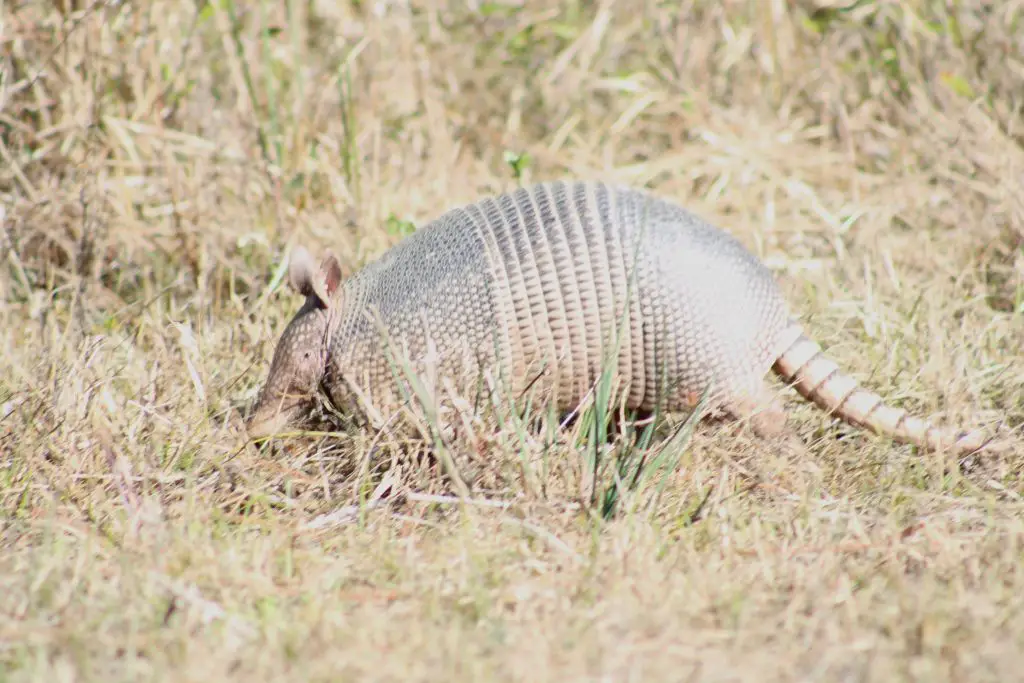
- Aardvark (Orycteropus afer). This nocturnal mammal, native to Africa, has a long snout and tongue, used to eat ants and termites.
- Aardwolf (Proteles cristata). Resembling a small hyena, the aardwolf is an insectivorous mammal found in East and Southern Africa.
- Abyssinian Genet (Genetta abyssinica): A small carnivore with a spotted coat, the Abyssinian genet lives in parts of East Africa.
- African Elephant (Loxodonta africana): The largest land mammal, African elephants have large ears and tusks, inhabiting various regions of Africa.
- African Golden Cat (Caracal aurata): This elusive wild cat, found in the rainforests of West and Central Africa, has a striking golden coat.
- Agouti (_Dasyprocta spp.): A rodent native to Central and South America, the agouti plays a crucial role in seed dispersal in tropical forests.
- Alpaca (Vicugna pacos): Domesticated from South American wild vicuñas, alpacas have valuable wool and are kept in the Andes.
- Amazon River Dolphin (Inia geoffrensis): Also known as the pink river dolphin, this freshwater dolphin inhabits the Amazon and Orinoco river basins.
- Anteater (Myrmecophagidae family): The anteater, with its long snout and tongue, feeds primarily on ants and termites in Central and South America.
- Arctic Fox (Vulpes lagopus): Adapted to cold climates, the Arctic fox has a thick fur coat and lives in Arctic regions.
- Arctic Hare (Lepus arcticus): Sporting a white coat in winter, the Arctic hare is adapted to the harsh environments of the Arctic tundra.
- Arctic Wolf (Canis lupus arctos): Subspecies of the gray wolf, the Arctic wolf thrives in the Arctic regions, exhibiting a white fur coat.
- Armadillo (Dasypodidae family): Armadillos, with their protective armor-like shell, live in various habitats in the Americas.
- Alpine Marmot (Marmota marmota): The Alpine marmot is a large ground-dwelling rodent that inhabits the apline regions of Europe.
- Amur Leopard (Panthera pardus orientalis): Critically endangered, the Amur leopard is a subspecies of leopard native to the Russian Far East.
- Anoa (Bubalus depressicornis): Found on the Indonesian island of Sulawesi, the anoa is a small buffalo species.
- Arabian Oryx (Oryx leucoryx): Adapted to desert environments, the Arabian oryx is a large antelope native to the Arabian Peninsula.
- Arctic Ground Squirrel (Spermophilus parryii): Inhabiting the Arctic tundra, this ground squirrel hibernates during the winter months.
- Australian Sea Lion (Neophoca cinerea): Endemic to Australia, the Australian sea lion is a marine mammal that breeds on coastal islands.
- Azara’s Night Monkey (Aotus azarae): Nocturnal and native to South America, Azara’s night monkey is a primate with large eyes adapted for low-light conditions.
- African Clawless Otter (Aonyx capensis): Found in various aquatic habitats in Africa, this otter lacks the typical claws associated with other otter species.
- Addax (Addax nasomaculatus): Adapted to desert life, the addax is a critically endangered antelope species native to the Sahara Desert.
Birds: 40 Animals That Start With A
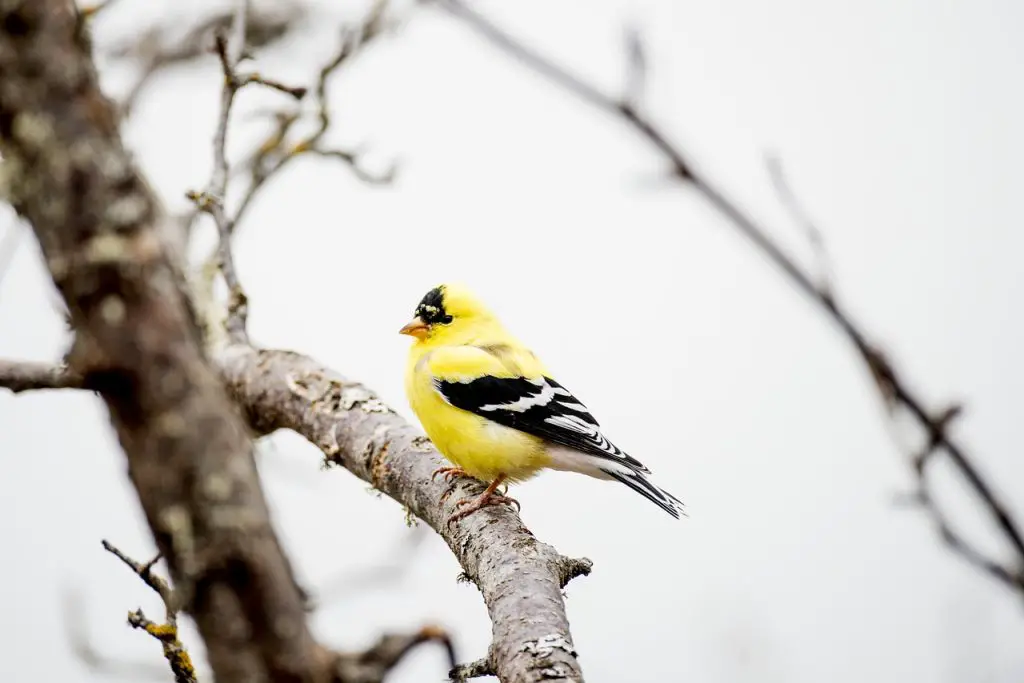
- African Fish Eagle (Haliaeetus vocifer): This large eagle lives near water bodies in sub-Saharan Africa.
- American Goldfinch (Spinus tristis): With vibrant yellow plumage, the American goldfinch is a common sight across North America.
- Andean Condor (Vultur gryphus): South America’s largest flying bird, the Andean condor, soars over the Andes mountains.
- Atlantic Puffin (Fratercula arctica): Distinctive for its colorful beak, the Atlantic puffin breeds in colonies on coastal cliffs.
- Anna’s Hummingbird (Calypte anna): Native to the western coastal regions of North America, this hummingbird has iridescent plumage.
- Australian King Parrot (Alisterus scapularis): Endemic to eastern Australia, the Australian king parrot showcases striking red and green colors.
- Azure-winged Magpie (Cyanopica cyanus): Found in parts of Europe and Asia, this magpie species has distinctive blue and white wings.
- Alder Flycatcher (Empidonax alnorum): Breeding in North American forests, the alder flycatcher has distinctive vocalizations.
- Asian Paradise Flycatcher (Terpsiphone paradisi): With long tail feathers, this flycatcher lives in various Asian countries.
- Aplomado Falcon (Falco femoralis): Inhabiting open grasslands, the aplomado falcon lives in the Americas.
- American Kestrel (Falco sparverius): A small falcon found across the Americas, the American kestrel exhibits hovering flight.
- Acorn Woodpecker (Melanerpes formicivorus): Inhabiting North and Central America, this woodpecker stores acorns in tree bark.
- Albert’s Lyrebird (Menura alberti): Endemic to Australia, Albert’s lyrebird has intricate tail feathers and mimicry skills.
- American Robin (Turdus migratorius): A migratory songbird, the American robin is widespread across North America.
- Andean Hillstar (Oreotrochilus estella): Adapted to high-altitude environments, this hummingbird lives in the Andes mountains.
- Australian Brush Turkey (Alectura lathami): Native to Australia, this large bird builds massive nest mounds.
- African Grey Hornbill (Lophoceros nasutus): Found in savannas and woodlands, the African grey hornbill has a distinctive casque on its bill.
- Ashy Prinia (Prinia socialis): Inhabiting grasslands and open areas, the ashy prinia lives in parts of Asia.
- Andean Cock-of-the-rock (Rupicola peruvianus): Known for its vibrant orange plumage, this bird lives in Andean cloud forests.
- American Redstart (Setophaga ruticilla): A colorful warbler, the American redstart breeds in North America and migrates to Central and South America.
- African Penguin (Spheniscus demersus): Also known as the jackass penguin, this species lives along the coasts of southern Africa.
- Ash-throated Flycatcher (Myiarchus cinerascens): Native to North and Central America, this flycatcher resides in arid habitats.
- Asian Brown Flycatcher (Muscicapa dauurica): Migrating between Asia and Southeast Asia, this flycatcher breeds in northern regions.
- African Jacana (Actophilornis africanus): Recognized for its long toes, the African jacana walks on floating vegetation in wetlands.
- Asian Fairy-bluebird (Irena puella): With striking blue plumage, this bird lives in South and Southeast Asia.
- American Tree Sparrow (Spizelloides arborea): Breeding in the Arctic tundra, this sparrow migrates southward during winter.
- Arctic Tern (Sterna paradisaea): Known for its remarkable long-distance migration, the Arctic tern travels between the Arctic and Antarctic.
- Abyssinian Roller (Coracias abyssinica): Found in parts of Africa, the Abyssinian roller is known for its aerial acrobatics.
- African Sacred Ibis (Threskiornis aethiopicus): Native to Africa and the Middle East, this bird is associated with Egyptian mythology.
- Australian Owlet-nightjar (Aegotheles cristatus): A nocturnal bird found in Australia, the Australian owlet-nightjar has large eyes adapted for low light.
- American Oystercatcher (Haematopus palliatus): Inhabiting coastal areas, this oystercatcher has a distinctive long, orange bill.
- Antarctic Petrel (Thalassoica antarctica): The seabird breeds in the Southern Ocean. The Antarctic petrel is adapted to cold Antarctic waters.
- African Pygmy Kingfisher (Ispidina picta): With vibrant plumage, this kingfisher lives in various habitats across sub-Saharan Africa.
- Asian Emerald Cuckoo (Chrysococcyx maculatus): Inhabiting Southeast Asia, this cuckoo species has iridescent green plumage.
- Alder Pipit (Anthus aldi): Found in Arctic and subarctic regions, the alder pipit is a migratory bird.
- Andean Swallow (Orochelidon andecola): Inhabiting the Andes mountains, this swallow species is adapted to high-altitude flight.
- African Hoopoe (Upupa africana): Known for its distinctive crown of feathers, the African hoopoe lives in sub-Saharan Africa.
- Amethyst Sunbird (Chalcomitra amethystina): Native to sub-Saharan Africa, this sunbird species has vibrant purple and green plumage.
- Azure Tit (Cyanistes cyanus): Inhabiting woodlands in parts of Europe and Asia, the azure tit has a azure blue cap.
Reptiles: 27 Animals That Start With A
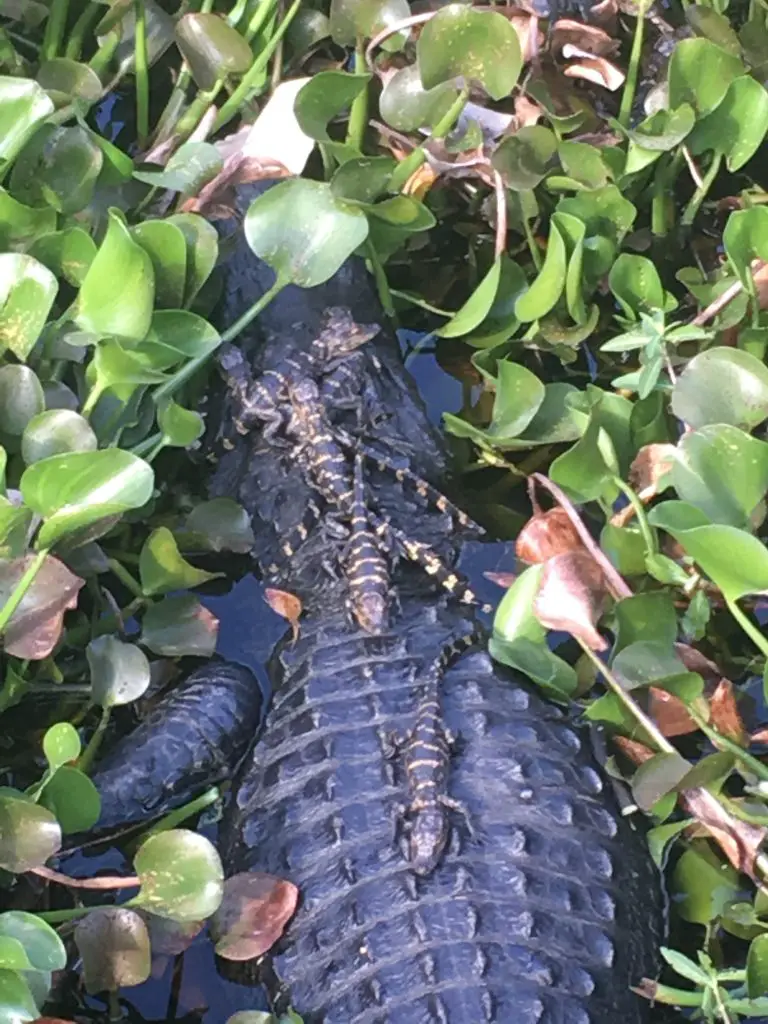
- American Alligator (Alligator mississippiensis): Found in the southeastern United States, the American alligator is a large aquatic reptile.
- Anaconda (_Eunectes spp.): Large, non-venomous snakes live South America.
- Armadillo Girdled Lizard (Ouroborus cataphractus): Native to desert regions of southern Africa, this lizard has armored scales.
- Aldabra Giant Tortoise (Aldabrachelys gigantea): Native to the Aldabra Atoll in Seychelles, this tortoise is one of the largest in the world.
- Aesculapian Snake (Zamenis longissimus): Found in Europe, the Aesculapian snake is non-venomous and often associated with healing symbolism.
- Amazon Tree Boa (Corallus hortulanus): Inhabiting the Amazon rainforest, this arboreal snake has a distinctive pattern.
- Arabian Sand Boa (Eryx jayakari): Native to the Middle East, this burrowing snake thrives in arid desert environments.
- African Rock Python (Python sebae): One of the largest snake species, the African rock python lives in sub-Saharan Africa.
- Agama Lizard (Agamidae family): A diverse family of lizards found in Africa, Asia, and parts of Europe, known for their colorful displays.
- Australian Frilled Lizard (Chlamydosaurus kingii): Native to northern Australia and New Guinea, this lizard has a distinctive frill around its neck.
- African Spurred Tortoise (Centrochelys sulcata): Native to the Sahel region in Africa, this tortoise has distinctive spurs on its legs.
- Aruba Island Rattlesnake (Crotalus unicolor): Endemic to Aruba, this venomous rattlesnake is one of the rarest rattlers in the world.
- Asian Vine Snake (_Ahaetulla spp.): Found in South and Southeast Asia, these arboreal snakes have slender bodies.
- Alligator Lizard (_Elgaria spp.): Native to North America, alligator lizards have keeled scales.
- African Egg-Eating Snake (_Dasypeltis spp.): Non-venomous snakes found in Africa, known for their diet consisting mainly of bird eggs.
- Amazon River Turtle (_Podocnemis spp.): Inhabiting South American rivers, Amazon river turtles have distinctive flattened shells.
- Amazon Horned Frog (Ceratophrys cornuta): Found in South America, these large frogs have distinctive horn-like projections.
- Australian Water Dragon (Intellagama lesueurii): Native to Australia, these semi-aquatic lizards are known for their vibrant coloration.
- Arizona Coral Snake (Micruroides euryxanthus): A venomous snake found in the southwestern United States and Mexico.
- Anatolian Viper (Vipera anatolica): Native to Turkey, this venomous viper lives in rocky habitats.
- Amber Mountain Leaf Chameleon (Brookesia ambreensis): Endemic to Madagascar, this tiny chameleon inhabits montane forests.
- Algerian Whip Snake (Hierophis carbonarius): Found in North Africa, this slender snake possesses impressive agility.
- Afghan Tortoise (Testudo horsfieldii): Native to Central Asia, the Afghan tortoise thrives in arid and rocky environments.
- Australian Bearded Dragon (_Pogona spp.): Native to Australia, bearded dragons are popular as pets. You might know about their bread displays.
- Anguilla Bank Anole (Anolis gingivinus): Endemic to the Caribbean, this anole species lives on Anguilla Bank.
- Antiguan Racer (Alsophis antiguae): Native to Antigua and Barbuda, this snake is critically endangered and endemic to the islands.
- Armenian Viper (Montivipera raddei): Found in Armenia and neighboring countries, this viper inhabits mountainous areas.
Amphibians: 25 Animals That Start With A
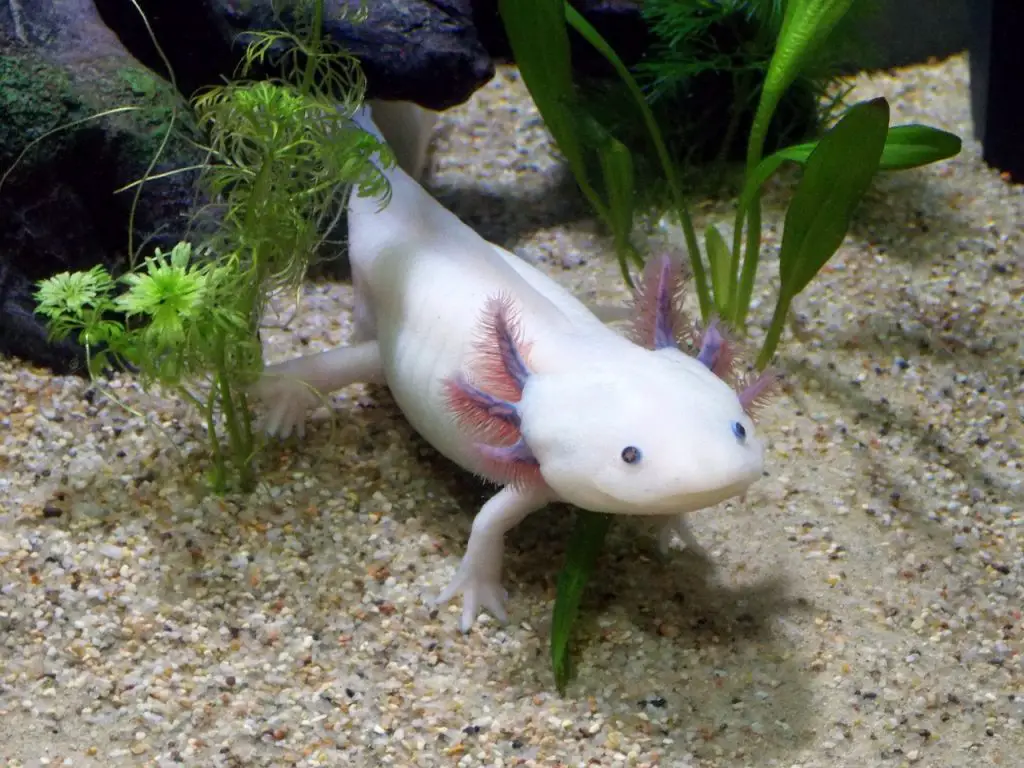
- American Bullfrog (Lithobates catesbeianus): Native to North America, the American bullfrog is one of the largest frog species.
- Arroyo Toad (Anaxyrus californicus): Found in California and Baja California, this toad species survives in arid environments.
- Amazon Milk Frog (Trachycephalus resinifictrix): Native to South America, this tree frog has a distinctive appearance with white and dark brown markings.
- Axolotl (Ambystoma mexicanum): Endemic to Mexico, the axolotl is a unique amphibian that exhibits neoteny, retaining its aquatic larval form throughout its life.
- Asian Giant Salamander (Andrias spp.): Found in East Asia, these large salamanders are among the largest amphibians globally.
- Alpine Newt (Ichthyosaura alpestris): Inhabiting parts of Europe, the alpine newt showcases its bright colors during the breeding season.
- Arboreal Salamander (Aneides lugubris): Native to the western United States, this salamander is adapted to climbing and arboreal habitats.
- Afrixalus (Afrixalus spp.): A genus of tree frogs found in Africa, Afrixalus species are known for their vibrant colors.
- Amphiuma Salamander (_Amphiuma spp.): Found in the southeastern United States, amphiumas are large, aquatic salamanders with elongated bodies.
- Arizona Toad (Anaxyrus microscaphus): Inhabiting the southwestern United States, the Arizona toad thrives in arid conditions.
- Australian Green Tree Frog (Litoria caerulea): Native to Australia and New Guinea, this tree frog has a vibrant green coloration.
- African Clawed Frog (Xenopus laevis): Native to sub-Saharan Africa. This aquatic frog is often used in scientific research.
- Alajuela Glass Frog (Hyalinobatrachium chirripoi): Endemic to Costa Rica, this glass frog has transparent skin, revealing internal organs.
- Assam Roofed Turtle (Pangshura sylhetensis): Native to South Asia, this freshwater turtle lives in rivers and ponds.
- Albino African Clawed Frog (Xenopus laevis): A color morph of the African clawed frog, albino individuals lack pigmentation.
- Alpine Salamander (Salamandra atra): Inhabiting alpine regions of Europe, this salamander is active even in cold temperatures.
- Araucaria Tree Frog (Hypsiboas geographicus): Found in South America, usually living on Araucaria trees.
- Assam Bubble-nest Frog (Raorchestes resplendens): Endemic to India, this frog species constructs foam nests for its eggs.
- Axanthic Pacman Frog (Ceratophrys cranwelli): A color morph of the Pacman frog, axanthic individuals lack yellow pigmentation.
- Annam Flying Frog (Rhacophorus annamensis): Native to Southeast Asia, this flying frog glides between trees using its webbed feet.
- Alpine Salamander (Salamandra atra): Inhabiting alpine regions of Europe, this salamander is active even in cold temperatures.
- African Bullfrog (Pyxicephalus adspersus): Found in southern Africa, the African bullfrog showcases a large size and distinctive vocalizations.
- Antiguan Robber Frog (Eleutherodactylus coqui): Native to Puerto Rico. But the species has spread to other locations.
- Australasian Smooth Frog (_Geocrinia spp.): Found in Australia, these frogs belong to a genus known for their smooth skin.
Fish: 28 Animals That Start With A
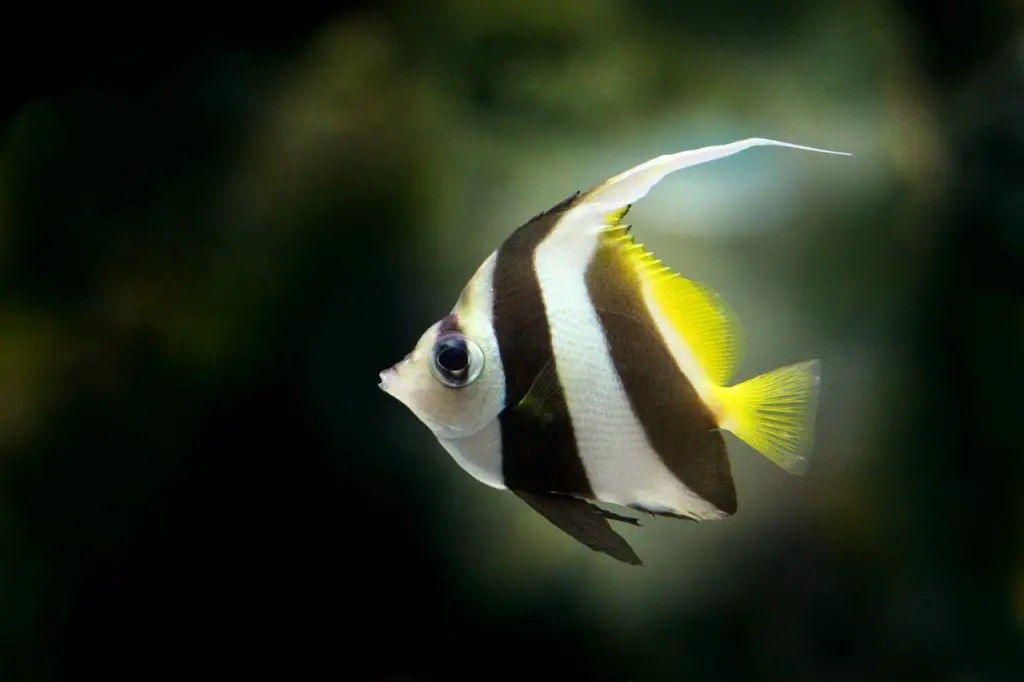
- Angelfish (Pterophyllum spp.): Native to South America, angelfish are popular aquarium fish with distinctive vertical stripes and elongated fins.
- Archerfish (Toxotidae family): Inhabiting brackish and freshwater in Southeast Asia and Australia, archerfish have a unique ability to shoot down prey by spitting water.
- Arowana (Osteoglossidae family): Found in South America, Africa, Asia, and Australia, arowanas are large, predatory fish known for their bony heads and elongated bodies.
- Atlantic Salmon (Salmo salar): A migratory fish species found in the Atlantic Ocean, Atlantic salmon are known for their epic upstream journeys to spawn.
- Arctic Char (Salvelinus alpinus): Inhabiting cold, northern waters, Arctic char are a type of salmonid with their distinctive red underbellies.
- Asian Arowana (Scleropages formosus): Also known as the dragon fish, the Asian arowana is a prized ornamental fish with vibrant colors and unique scales.
- Australian Lungfish (Neoceratodus forsteri): Native to Australia, the Australian lungfish possesses the ability to breathe air and survive in oxygen-poor waters.
- American Eel (Anguilla rostrata): Found in rivers along the eastern coast of North America, the American eel undergoes extensive migrations to spawn.
- Alligator Gar (Atractosteus spatula): Inhabiting freshwater rivers in North America, the alligator gar is a large, predatory fish with an alligator-like appearance.
- Amberjack (_Seriola spp.): A group of predatory fish found in warm waters, amberjacks possess strong swimming abilities.
- Atlantic Herring (Clupea harengus): A key species in marine food webs, Atlantic herring are schooling fish found in the North Atlantic.
- Anchovy (Engraulidae family): Small, oily fish found in marine waters worldwide.
- Arctic Cisco (Coregonus autumnalis): Inhabiting cold northern waters, Arctic cisco are freshwater fish related to whitefish and trout.
- African Glass Catfish (Parailia pellucida): Found in African freshwater rivers, glass catfish have transparent bodies.
- Australian Flathead (Platycephalidae family): A diverse family of bottom-dwelling fish found in Australian waters. As the name suggests, flatheads have flattened heads.
- Atlantic Cod (Gadus morhua): A commercially important fish in the North Atlantic.
- Australian Sawtail (Pristis microdon): Also known as the freshwater sawfish, this elasmobranch species lives in Australian rivers.
- African Lungfish (Protopterus spp.): Native to Africa, African lungfish possess the ability to aestivate during dry periods by burrowing in mud.
- Alfonsino (Berycidae family): Deep-sea fish found in various oceanic regions, alfonsinos have a vibrant coloration.
- Atlantic Bonito (Sarda sarda): Found in Atlantic and Mediterranean waters, Atlantic bonito are fast-swimming, migratory fish.
- African Tigerfish (Hydrocynus spp.): Inhabiting rivers and lakes in Africa, tigerfish are apex predators possess sharp teeth.
- Arapaima (Arapaima gigas): Native to the Amazon Basin, the arapaima is one of the largest freshwater fish, known for its breath-taking ability.
- Asian Sea Bass (Lates calcarifer): Also known as barramundi, Asian sea bass are widely distributed in the Indo-Pacific region and are prized in aquaculture.
- African Pike (Hepsetus spp.): Found in African freshwater rivers, African pike are predatory fish with slender bodies and sharp teeth.
- Atlantic Needlefish (Strongylura marina): Inhabiting coastal waters, Atlantic needlefish have long, slender bodies and needle-like beaks.
- Antarctic Toothfish (Dissostichus mawsoni): This fish lives in some of the most unforgiving regions of the planet.
- Albacore Tuna (Thunnus alalunga): Found in warm and temperate seas worldwide, albacore tuna are popular targets for commercial and sport fishing.
- Australian Ghost Shark (Callorhinchus milii): Also known as elephant fish, Australian ghost sharks inhabit deep
Invertebrates: 23 Animals That Start With A
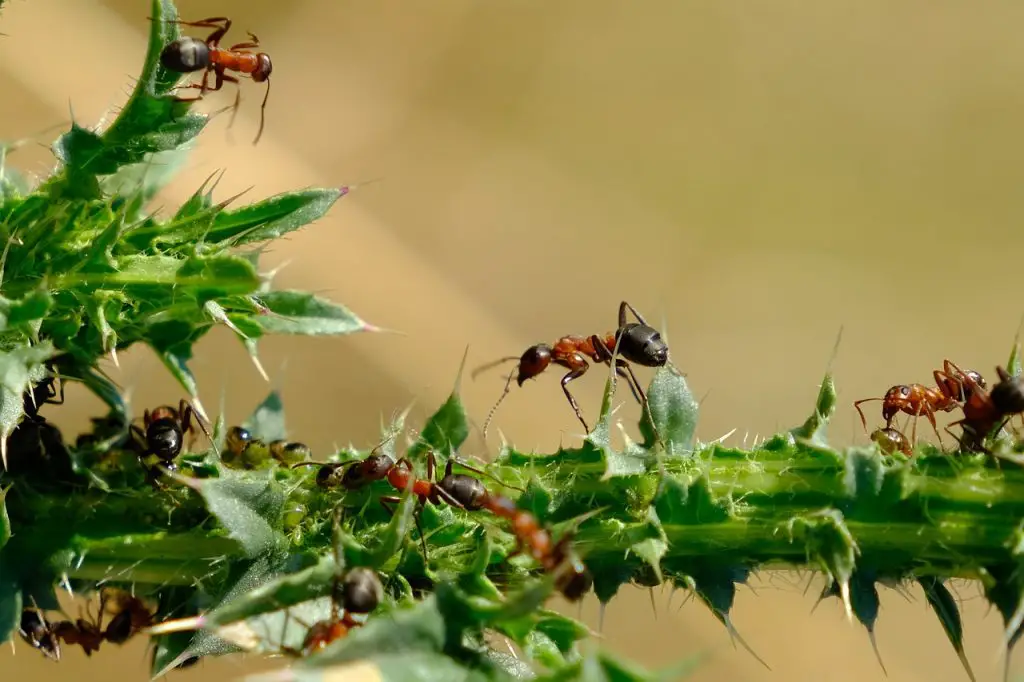
- Ant (Formicidae family): Found worldwide, ants are social insects. They have elaborate colonies, division of labor, and complex communication.
- African Giant Snail (Achatina fulica): Native to East Africa, the African giant snail is one of the largest terrestrial snails, often considered an invasive species.
- Atlas Moth (Attacus atlas): Native to Southeast Asia, the Atlas moth is one of the largest moths with a distinctive wing pattern and size.
- Asian Giant Hornet (Vespa mandarinia): Found in East Asia, the Asian giant hornet is the world’s largest hornet, known for its aggressive behavior.
- Arrow Crab (Stenorhynchus seticornis): Inhabiting coral reefs in the Atlantic Ocean, arrow crabs are marine crustaceans with long, spindly legs.
- Achelata Lobster (Homarida infraorder): Including species like the spiny lobster, Achelata lobsters have no claws and long antennae.
- Apple Snail (Pomacea canaliculata): Native to South America, these freshwater snails often kept in aquariums.
- Amazonian Giant Centipede (Scolopendra gigantea): Inhabiting South America, this giant centipede is a carnivorous invertebrate with a venomous bite.
- Africanized Honey Bee (Apis mellifera scutellata): Also known as the “killer bee,” this bee subspecies is more aggressive than its European counterpart.
- Atlas Beetle (Chalcosoma atlas): Native to Southeast Asia, the atlas beetle is one of the largest species of beetle with impressive horn-like structures.
- Assassin Bug (Reduviidae family): A diverse family of predatory bugs, assassin bugs earned their name from stealthy hunting behavior.
- American Bumblebee (Bombus pensylvanicus): Native to North America, the American bumblebee is a vital pollinator in various ecosystems.
- Alfalfa Weevil (Hypera postica): Native to Europe, the alfalfa weevil is an agricultural pest that feeds on alfalfa crops.
- African Flower Mantis (_Creobroter spp.): Found in Africa and Asia, flower mantises possess a strong resemblance to flowers.
- Amphipod (Amphipoda order): A diverse order of crustaceans found in marine and freshwater environments, amphipods have a laterally compressed body.
- Anemone Shrimp (_Periclimenes spp.): These small shrimp inhabit sea anemones and have a symbiotic relationship with their hosts.
- Atlas Cowries (Cypraeidae family): Atlas cowries are a group of sea snails with glossy shells, found in tropical oceans.
- American Dog Tick (Dermacentor variabilis): Found in North America, the American dog tick is a common ectoparasite that feeds on various hosts.
- Arctic Woolly Bear Caterpillar (Gynaephora groenlandica): Native to the Arctic tundra, this caterpillar lives in cold climates.
- African Violet Stick Insect (Ramulus artemis): Found in Africa, it mimics vegetation. Sometimes people keep these critters as pets.
- Antlion (Myrmeleontidae family): Antlions are predatory insects in their larval stage, known for building conical pits to trap ants.
- Asian Longhorn Beetle (Anoplophora glabripennis): Native to East Asia, this beetle species is an invasive pest in many regions.
- Amazonian Giant Water Bug (Belostomatidae family): These large aquatic bugs live in the Amazon Basin.
Animals That Start With A: Highlighted Favorites
After reading through that extensive list of animals that start with A, you might want to get to know these animals a bit better. I’ve pulled out some of my favorite animals from the list above to provide you with more information about these awesome animals.
Alligator
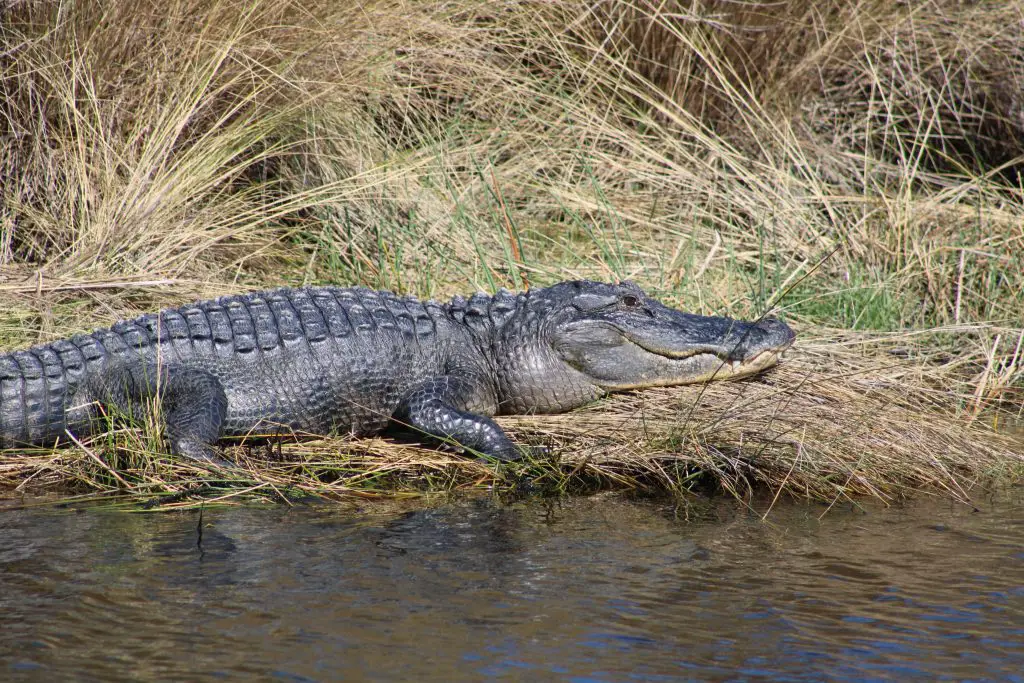
Since I live in Florida, the American Alligator might be the animal that I encounter most frequently from the list above. These impressive animals are not to be trifled with. But I often see them when I’m out on the water or hiking near a water body. As the joke goes, there’s likely an alligator in every single water body of Florida *including puddles*.
Adult males can reach lengths of up to 13 feet or more, while females tend to be slightly smaller. Their powerful tails, designed for swift aquatic movement, make them proficient swimmers and contribute to their formidable presence in freshwater habitats.
Noteworthy for their role as “ecosystem engineers,” American alligators play a crucial role in maintaining the health of their habitats. By creating alligator holes—depressions in the landscape—they provide refuge for other aquatic species during dry spells and promote overall biodiversity. Despite their resilience, American alligators faced severe population declines due to hunting and habitat loss in the past. However, conservation efforts and protective measures have led to their recovery.
If you take a trip to Florida, you are likely to come in contact with these dinosaur-like creatures.
American Oystercatcher
The American oystercatcher is a striking shorebird inhabiting coastal regions of North and South America. It has distinct black and white plumage, a long orange bill, and bright yellow eyes. It lives primarily in intertidal environments. Its specialized bill is adapted for prying open shellfish, making mollusks like oysters and clams a primary component of its diet.
American oystercatchers engage in intricate courtship rituals involving calls, aerial displays, and the exchange of symbolic objects like shells or twigs. These behaviors contribute to the strong pair bonds that are essential for successful breeding.
American Bumblebee
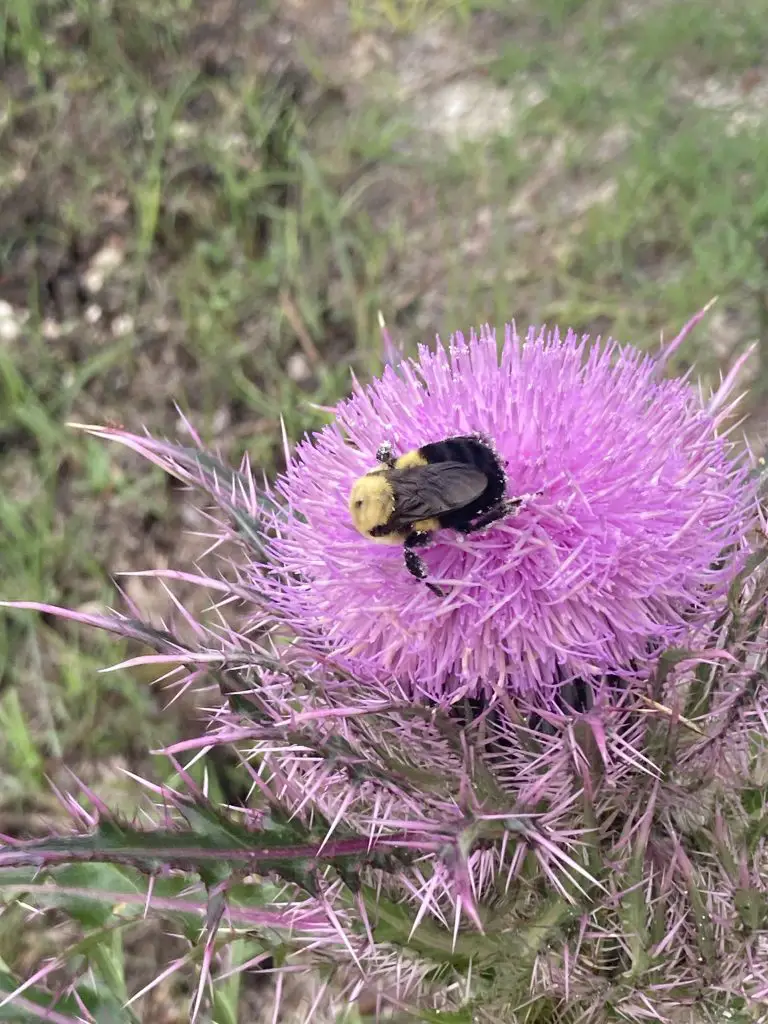
The American bumblebee, scientifically known as Bombus pensylvanicus, is a vital pollinator native to North America. Recognized for its fuzzy appearance, characterized by yellow and black stripes, the American bumblebee plays a crucial role in ecosystem health and agricultural pollination. These robust insects exhibit a characteristic buzz while flying, and their large bodies contribute to their efficiency as pollinators, allowing them to carry more pollen than smaller bees.
Colonies are founded by a single queen in spring. Throughout the season, they can grow to include hundreds of worker bees. Unlike honeybees, bumblebee colonies, including the queen, die off in late fall, with new queens hibernating to start fresh colonies in the following spring. Despite their importance in pollination, American bumblebees, like many other bee species, face threats from habitat loss, pesticide exposure, and diseases.
Apple Snail
Apple snails are freshwater gastropods. These snails have a conical shell with a smooth, glossy surface. The shell is usually brown to golden. Their name is derived from the shape and size of their shells, which can resemble small apples. Apple snails have both gills and a lung, allowing them to breathe in water and air.
Most of these critters are native to South America. But some are native to the southern U.S. In Florida, four apple snail species thrive. But only one of the four types is native to the state.
They are known for laying large egg clutches on aquatic vegetation or hard surfaces above the waterline. These clutches can contain hundreds of eggs and are defended vigorously by the female. In Florida, the white egg clutches are from native snails while pink egg clutches are from invasive apple snails.
Armadillo

The armadillo, scientifically known as Dasypus novemcinctus, is a distinctive mammal recognized for its unique armor-like shell. Native to the Americas, armadillos have a bony exoskeleton covered by tough, overlapping scales, providing them with a protective shield. They are medium-sized mammals with a pointed snout and long claws, which they use for digging burrows and searching for insects, their primary food source.
If threatened, they will roll into a ball. Despite their impressive armor, armadillos are not impervious to all threats, particularly from vehicles, as they often cross roads in search of food.
Frequently Asked Questions
You have questions about animals that start with A. We have answers.
What animals starts with a double A?
Aardarks are animals that start with the letter A.

